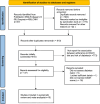Adherence to the dietary approaches to stop hypertension diet reduces the risk of diabetes mellitus: a systematic review and dose-response meta-analysis
- PMID: 38816664
- PMCID: PMC11445359
- DOI: 10.1007/s12020-024-03882-5
Adherence to the dietary approaches to stop hypertension diet reduces the risk of diabetes mellitus: a systematic review and dose-response meta-analysis
Abstract
Background: Despite several epidemiological studies reporting a significant association between adherence to the Dietary Approaches to Stop Hypertension (DASH) diet and the risk of diabetes mellitus, the results remain controversial. In this systematic review and meta-analysis, we aimed to summarize the existing evidence from published observational studies and evaluate the dose-response relationship between adherence to the DASH diet and diabetes mellitus risk.
Methods: We performed a systematic search for relevant articles published up to September 2023 using electronic databases of PubMed, Embase, Scopus, and China National Knowledge Infrastructure (CNKI). A random-effects model was applied to calculate the combined relative risks (RR) with 95% confidence intervals (CIs) for the highest compared to the lowest categories of DASH score in relation to diabetes mellitus risk. Heterogeneity among the included studies was assessed using the Cochran's Q test and I-squared (I2) statistic. Literature search, study selection, data extraction, and quality assessment were performed by two independent reviewers.
Results: Fifteen studies involving 557,475 participants and 57,064 diabetes mellitus cases were eligible for our analyses. Pooled analyses from included studies showed that high adherence to the DASH diet was significantly associated with a reduced risk of diabetes mellitus (RR: 0.82; 95% CI: 0.76-0.90, P < 0.001). Moreover, the dose-response meta-analysis revealed a linear trend between adherence to the DASH diet and diabetes mellitus (RR:0.99; 95%CI: 0.97-1.02, Pdose-response = 0.546, Pnonlinearity = 0.701). Subgroup analyses further revealed a significant inverse association between adherence to the DASH diet and diabetes mellitus risk in case-control studies (RR: 0.65; 95%CI: 0.29-1.43, P < 0.001), with a marginal inverse association in cohort studies (RR:0.83; 95%CI: 0.76-0.91, P < 0.001). Additionally, we conducted analyses separately by comparison and found a significant inverse association between DASH diet and diabetes mellitus risk in T3 vs T1 comparison studies (RR = 0.74; 95%CI: 0.64-0.86, P = 0.012).
Conclusion: The findings of this study demonstrate a protective association between adherence to the DASH diet and risk of diabetes mellitus. However, further prospective cohort studies and randomized controlled trials are needed to validate these findings.
Keywords: DASH diet; Diabetes mellitus; Dietary Approaches to Stop Hypertension; Epidemiology; Meta-analysis; Systematic review.
© 2024. The Author(s).
Conflict of interest statement
The authors declare no competing interests.
Figures








Similar articles
-
Association between adhering to a dietary approach to stop hypertension and risk of colorectal cancer: a systematic review and meta-analysis.BMC Gastroenterol. 2025 May 6;25(1):335. doi: 10.1186/s12876-025-03859-2. BMC Gastroenterol. 2025. PMID: 40329201 Free PMC article.
-
Adherence to the Dietary Approaches to Stop Hypertension diet reduces the risk of breast cancer: A systematic review and meta-analysis.Front Nutr. 2023 Jan 9;9:1032654. doi: 10.3389/fnut.2022.1032654. eCollection 2022. Front Nutr. 2023. PMID: 36698472 Free PMC article.
-
Adherence to the dietary approaches to stop hypertension diet and risk of stroke: A meta-analysis of prospective studies.Medicine (Baltimore). 2018 Sep;97(38):e12450. doi: 10.1097/MD.0000000000012450. Medicine (Baltimore). 2018. PMID: 30235731 Free PMC article.
-
Dietary Approaches to Stop Hypertension and risk of chronic kidney disease: A systematic review and meta-analysis of observational studies.Clin Nutr. 2020 Jul;39(7):2035-2044. doi: 10.1016/j.clnu.2019.10.004. Epub 2019 Oct 15. Clin Nutr. 2020. PMID: 31669002
-
Adherence to the dietary approaches to stop hypertension (DASH) diet in relation to all-cause and cause-specific mortality: a systematic review and dose-response meta-analysis of prospective cohort studies.Nutr J. 2020 Apr 22;19(1):37. doi: 10.1186/s12937-020-00554-8. Nutr J. 2020. PMID: 32321528 Free PMC article.
Cited by
-
Oxidative Stress and Cardiovascular Complications in Type 2 Diabetes: From Pathophysiology to Lifestyle Modifications.Antioxidants (Basel). 2025 Jan 9;14(1):72. doi: 10.3390/antiox14010072. Antioxidants (Basel). 2025. PMID: 39857406 Free PMC article. Review.
-
Association between adhering to a dietary approach to stop hypertension and risk of colorectal cancer: a systematic review and meta-analysis.BMC Gastroenterol. 2025 May 6;25(1):335. doi: 10.1186/s12876-025-03859-2. BMC Gastroenterol. 2025. PMID: 40329201 Free PMC article.
-
Joint association of the newly proposed dietary index for gut microbiota and sleep disorders with survival among US adult population with diabetes and pre-diabetes.Nutr J. 2025 Jun 18;24(1):95. doi: 10.1186/s12937-025-01162-0. Nutr J. 2025. PMID: 40533747 Free PMC article.
-
Association of Four Dietary Patterns and Stair Climbing with Major Adverse Cardiovascular Events: A Large Population-Based Prospective Cohort Study.Nutrients. 2024 Oct 22;16(21):3576. doi: 10.3390/nu16213576. Nutrients. 2024. PMID: 39519409 Free PMC article.
References
-
- International Diabetes Federation. Diabetes facts & figures. https://idf.org/aboutdiabetes/what-is-diabetes/factsfigures.html.
-
- International Diabetes Federation. IDF Diabetes Atla. 10th ed. (2023). http://www.diabetesatlas.org.
Publication types
MeSH terms
LinkOut - more resources
Full Text Sources
Medical

